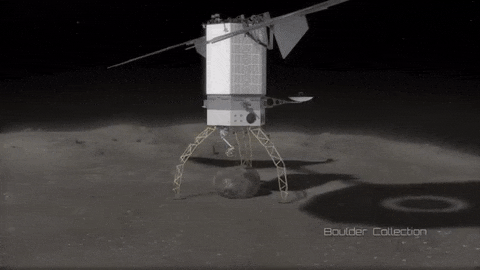Curate, connect, and discover
Asteroid - Blog Posts
Mission Possible: Redirecting an Asteroid
As part of our Asteroid Redirect Mission (ARM), we plan to send a robotic spacecraft to an asteroid tens of millions of miles away from Earth, capture a multi-ton boulder and bring it to an orbit near the moon for future crew exploration.

This mission to visit a large near-Earth asteroid is part of our plan to advance the new technologies and spaceflight experience needed for a human mission to the Martian system in the 2030s.
How exactly will it work?
The robotic spacecraft, powered by the most advanced solar electric propulsion system, will travel for about 18 months to the target asteroid.

After the spacecraft arrives and the multi-ton boulder is collected from the surface, the spacecraft will hover near the asteroid to create a gravitational attraction that will slightly change the asteroid’s trajectory.

After the enhanced gravity tractor demonstration is compete, the robotic vehicle will deliver the boulder into a stable orbit near the moon. During the transit, the boulder will be further imaged and studied by the spacecraft.

Astronauts aboard the Orion spacecraft will launch on the Space Launch System rocket to explore the returned boulder.

Orion will dock with the robotic vehicle that still has the boulder in its grasp.

While docked, two crew members on spacewalks will explore the boulder and collect samples to bring back to Earth for further study.

The astronauts and collected samples will return to Earth in the Orion spacecraft.
How will ARM help us send humans to Mars in the 2030s?

This mission will demonstrate future Mars-level exploration missions closer to home and will fly a mission with technologies and real life operational constraints that we’ll encounter on the way to the Red Planet. A few of the capabilities it will help us test include:
Solar Electric Propulsion – Using advanced Solar Electric Propulsion (SEP) technologies is an important part of future missions to send larger payloads into deep space and to the Mars system. Unlike chemical propulsion, which uses combustion and a nozzle to generate thrust, SEP uses electricity from solar arrays to create electromagnetic fields to accelerate and expel charged atoms (ions) to create a very low thrust with a very efficient use of propellant.
Trajectory and Navigation – When we move the massive asteroid boulder using low-thrust propulsion and leveraging the gravity fields of Earth and the moon, we’ll validate critical technologies for the future Mars missions.
Advances in Spacesuits – Spacesuits designed to operate in deep space and for the Mars surface will require upgrades to the portable life support system (PLSS). We are working on advanced PLSS that will protect astronauts on Mars or in deep space by improving carbon dioxide removal, humidity control and oxygen regulation. We are also improving mobility by evaluating advances in gloves to improve thermal capacity and dexterity.
Sample Collection and Containment Techniques – This experience will help us prepare to return samples from Mars through the development of new techniques for safe sample collection and containment. These techniques will ensure that humans do not contaminate the samples with microbes from Earth, while protecting our planet from any potential hazards in the samples that are returned.
Rendezvous and Docking Capabilities – Future human missions to Mars will require new capabilities to rendezvous and dock spacecraft in deep space. We will advance the current system we’ve developed with the international partners aboard the International Space Station.
Moving from spaceflight a couple hundred miles off Earth to the proving ground environment (40,000 miles beyond the moon) will allow us to start accumulating experience farther than humans have ever traveled in space.
Make sure to follow us on Tumblr for your regular dose of space: http://nasa.tumblr.com
Why Bennu?
Our OSIRIS-REx spacecraft will travel to a near-Earth asteroid, called Bennu, where it will collect a sample to bring back to Earth for study.
But why was Bennu chosen as the target destination asteroid for OSIRIS-REx? The science team took into account three criteria: accessibility, size and composition.

Accessibility: We need an asteroid that we can easily travel to, retrieve a sample from and return to Earth, all within a few years time. The closest asteroids are called near-Earth objects and they travel within 1.3 Astronomical Units (AU) of the sun. For those of you who don’t think in astronomical units…one Astronomical Unit is approximately equal to the distance between the sun and the Earth: ~93 million miles.

For a mission like OSIRIS-REx, the most accessible asteroids are somewhere between 0.08 – 1.6 AU. But we also needed to make sure that those asteroids have a similar orbit to Earth. Bennu fit this criteria! Check!
Size: We need an asteroid the right size to perform two critical portions of the mission: operations close to the asteroid and the actual sample collection from the surface of the asteroid. Bennu is roughly spherical and has a rotation period of 4.3 hours, which is in our size criteria. Check!

Composition: Asteroids are categorized by their spectral properties. In the visible and infrared light minerals have unique signatures or colors, much like fingerprints. Scientists use these fingerprints to identify molecules, like organics. For primitive, carbon-rich asteroids like Bennu, materials are preserved from over 4.5 billion years ago! We’re talking about the start of the formation of our solar system here! These primitive materials could contain organic molecules that may be the precursors to life here on Earth, or elsewhere in our solar system.

Thanks to telescopic observations in the visible and the infrared, as well as in radar, Bennu is currently the best understood asteroid not yet visited by a spacecraft.
All of these things make Bennu a fascinating and accessible asteroid for the OSIRIS-REx mission.
Make sure to follow us on Tumblr for your regular dose of space: http://nasa.tumblr.com